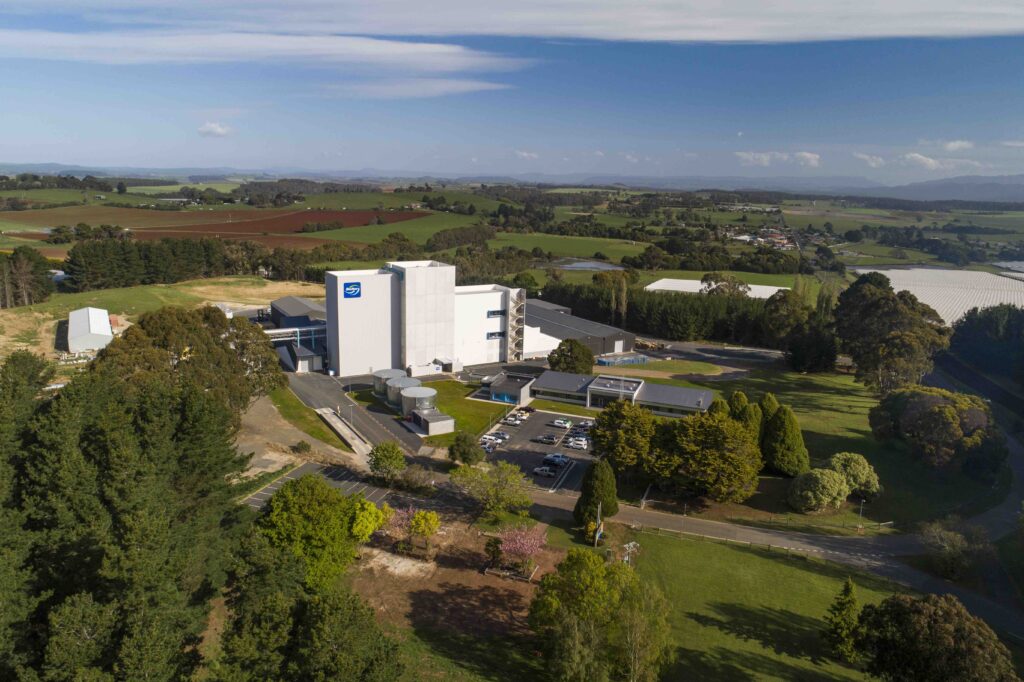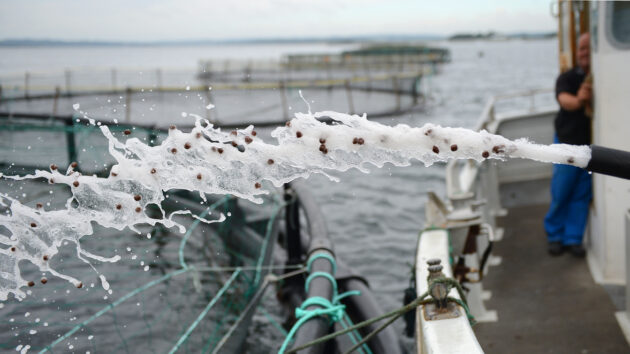
Features
Inside BioMar’s algal oil facility in Australia
March 16, 2023 By John Mosig
 BioMar plant at Wesley Vale, Tasmania, Australia (Photo: BioMar Group)
BioMar plant at Wesley Vale, Tasmania, Australia (Photo: BioMar Group) Reducing reliance on traditional wild-harvest sources of Omega-3 and Omega-6 rich ingredients has been a target of feed company’s research and development programs for decades. The industrialization of animal protein production has placed a global demand on several key ingredients.
In the case of aquaculture, fishmeal and oil have been central to the maintenance of fish health and economic production outcomes. The abundant oilier fish species such as menhaden, sardines and anchovies have long underwritten fishmeal production. Along with increased demand has come a fluctuating but persistent reduction in the annual wild harvest of these pelagic species.
Global food giant, BioMar, has been amongst those searching for a reliable and affordable alternative to the above scenarios, particularly in regards to oil. The company has built an algal oil inclusion facility at their new feed manufacturing plant in northern Tasmania, Australia. While around 80 per cent of the plant’s production is dedicated to producing salmon grow out rations, it also produces micro-pellets and algal diets for the hatchery and nursery sectors ranging from 500µm to 1.5mm.
The new mill is strategically situated near Tasmania’s container ports of Bell Bay and Burnie. This gives it easy access to inputs not available in Australia and equally easy access to markets in South East Asia, New Zealand and across the Pacific for their feed range.
Further to that, Tasmania has an abundance of hydro-electricity and already has a zero-greenhouse emissions power grid. It would be fair to say BioMar’s expansion into the Australasian and Pacific region is going to benefit the company, the Tasmania economy and the aquaculture industry.
Investigating algal oil
After extensive on-farm monitoring and analysis, the company says it is confident that algal oil was the fish oil replacement they had been seeking since 2013 and have included it in their commercial diet range since 2016.
If the proof of the pudding is in the eating, up to the end of 2021 their micro-algae product has been included in over a million tonnes of salmon feed around the world. This industry endorsement would suggest that algal oil can be used to supplement diets that have previously utilised fish oil and has proved to be a crucial step to decoupling aquafeeds’ reliance on this limited product.
BioiMar says it is working closely with industry and is able customize diets to suit the particular needs of their customers’ circumstances and runs feed trials with many of them to further improve the efficiency of the diet design.
In addition to offering customized diets, BioMar runs extensive feed trails with customers and researchers to further optimize their diets’ formulation and to test new and innovative ingredients. Conducting feed trails in commercial conditions is important in Tasmania.
The Tasmanian Salmon industry operates in exceptional conditions, with water temperatures higher than other major salmon farming countries. To counterbalance this, Tasmanian salmon have been bred to handle higher water temperatures, meaning they have a different genome to salmon grown in colder waters. Testing diets in commercial conditions allows BioMar to further optimize their offering for Tasmania salmon growers and offer feed solutions to farmers of other species.
Tasmanian salmon grower Huon Aquaculture have used diets that included algal oil for over a year now and the company’s CEO, David Mitchell, said there had been no impact on the nutritional value of their finished product nor on the growth and health of their fish.
“I feel confident that the new facility at Wesley Vale will prove to be a valuable addition to the Tasmanian salmon industry and right across the Australian and New Zealand aquaculture sectors,” he says.

Feeding salmon in Tasmania (Photo: BioMar Group)
Global market gaps
Alarmingly, since 1996 the harvest has halved from ~ 30m to > 16m tonnes in 2020. It equates to 20 per cent of the total wild harvest and is as vulnerable to fishing pressure, the vagaries of seasonal conditions and the extremes of climate change as any wild fishery. This has placed upward pressure on the cost of both a crucial feed component and added a supply risk.
The highly desirable balance of essential amino acids together with their concentration within a given weight of meal makes fishmeal a superior ingredient. Alternative ingredients, such as terrestrial protein sources, lack that balance and density. From high density hatchery and nursery diets to economically efficient growout rations, it makes formulating high performance diets difficult. That the digestibility of fish oil and meal is also high, in many respects, is the icing on the diet formulation cake.
To some degree, this fall off of availability has been off-set by utilizing fish production waste. According to data collected by the International Fishmeal and Fish Oil Organisation (IFFO) in 2021, 30 per cent of the fishmeal and 51 per cent of the fish oil produced came from that source.
To date, many substitute ingredients have been tried with the aim of reducing the reliance on this diminishing natural nutritional resource, particularly in hatchery and nursery diets, however, the success has been limited. Achieving the right balance of essential ingredients in a readily digestible form has proved elusive.
At the crucial hatchery and nursery stages, running algal rooms for rotifer production systems, while highly efficient, has always been a costly and labour-intensive element of hatchery operations, not to mention the usual risks associated with the health and water quality management issues of running a separate biosphere and the possibility of power failure or infrastructure breakdown.
Future planning
BioMar Australia’s managing director, David Whyte, saw the company’s recent commission of systems to incorporate algal oil into production as a turning point in aquaculture.
“By producing a sustainable and equitable substitute for a limited resource, it not only eases the pressure on that resource but it also stabilizes the cost of a major and essential input. More than that, being based on a plentiful and otherwise waste product, production can be scaled up to meet an increase in demand,” he says.
“With often repeated concerns of the amount of wild fish harvested to make up a kilo of farmed fish, inclusion of a non-fish source of Omega-3 also becomes a marketing tool. Tasmanian salmon is already a net protein producer, including algal oil in their ration will further reduce their fish-in-fish-out ration.”
Print this page
Advertisement
- High fish feed prices force Ghanaian fish farmers to close business
- Troutlodge general manager joins Northwest Aquaculture board





